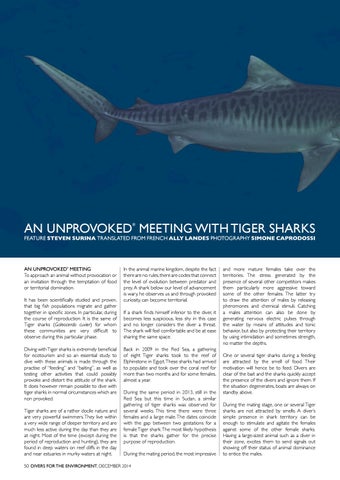AN UNPROVOKED* MEETING WITH TIGER SHARKS
FEATURE STEVEN SURINA TRANSLATED FROM FRENCH ALLY LANDES PHOTOGRAPHY SIMONE CAPRODOSSI
AN UNPROVOKED* MEETING To approach an animal without provocation or an invitation through the temptation of food or territorial domination. It has been scientifically studied and proven, that big fish populations migrate and gather together in specific zones. In particular, during the course of reproduction. It is the same of Tiger sharks (Galeocerdo cuvier) for whom these communities are very difficult to observe during this particular phase. Diving with Tiger sharks is extremely beneficial for ecotourism and so an essential study to dive with these animals is made through the practise of “feeding” and “baiting”, as well as testing other activities that could possibly provoke and distort the attitude of the shark. It does however remain possible to dive with tiger sharks in normal circumstances which are non provoked. Tiger sharks are of a rather docile nature and are very powerful swimmers. They live within a very wide range of deeper territory and are much less active during the day than they are at night. Most of the time (except during the period of reproduction and hunting), they are found in deep waters on reef cliffs in the day and near estuaries in murky waters at night.
In the animal marine kingdom, despite the fact there are no rules, there are codes that connect the level of evolution between predator and prey. A shark below our level of advancement is wary, he observes us and through provoked curiosity, can become territorial. If a shark finds himself inferior to the diver, it becomes less suspicious, less shy in this case and no longer considers the diver a threat. The shark will feel comfortable and be at ease sharing the same space. Back in 2009 in the Red Sea, a gathering of eight Tiger sharks took to the reef of Elphinstone in Egypt. These sharks had arrived to populate and took over the coral reef for more than two months and for some females, almost a year. During the same period in 2013, still in the Red Sea but this time in Sudan, a similar gathering of tiger sharks was observed for several weeks. This time there were three females and a large male. The dates coincide with the gap between two gestations for a female Tiger shark. The most likely hypothesis is that the sharks gather for the precise purpose of reproduction. During the mating period, the most impressive
50 DIVERS FOR THE ENVIRONMENT, DECEMBER 2014
and more mature females take over the territories. The stress generated by the presence of several other competitors makes them particularly more aggressive toward some of the other females. The latter try to draw the attention of males by releasing pheromones and chemical stimuli. Catching a males attention can also be done by generating nervous electric pulses through the water by means of attitudes and tonic behavior, but also by protecting their territory by using intimidation and sometimes strength, no matter the depths. One or several tiger sharks during a feeding are attracted by the smell of food. Their motivation will hence be to feed. Divers are clear of the bait and the sharks quickly accept the presence of the divers and ignore them. If the situation degenerates, boats are always on standby above. During the mating stage, one or several Tiger sharks are not attracted by smells. A diver’s simple presence in shark territory can be enough to stimulate and agitate the females against some of the other female sharks. Having a large-sized animal such as a diver in their zone, excites them to send signals out showing off their status of animal dominance to entice the males.
